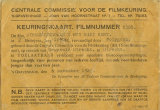Towards a National Film Censorship Board
In the Netherlands and abroad, the rise of film – and certainly its enormous popularity among the masses – led to the question of whether film shows were suitable for all audiences and if films should be censored before viewing. There was particular concern for young children, who were attending cinemas in great numbers from the very beginning.
Passionately discussed
This led to an intense discussion in the Netherlands during the early 1910s which came to be known as the Bioscope-quaestie (‘cinema question’), that thoroughly stirred up the emotions of many at the time. The pros and cons of supervision, censorship or banning of films was passionately debated, but people soon agreed that, no matter what, children should no longer be allowed unlimited access to all films.
Just as in Germany, the Dutch decided to opt for local film censorship boards. By making an appeal to Article 188, mayors could ban films that were considered to be threats to the public order or obscene. In the end, it was the mayor’s responsibility to ban films. He was allowed, however, ask the advice of third parties – which he did indeed do, and often it ws these local film boards that did the actual censoring. Rotterdam and Sittard were the first cities to institute such boards, and they were followed by many others. In actuality, the regulatory supervision of film screenings was in the hands of these film boards.
Arbitrary decisions
In order to facilitate clear agreements and a censorship policy that was as consistent as possible, the Vereeniging van gemeentelijke en particuliere Bioscoopcommissies in Nederland was founded. Cinema owners were afraid that the differences between the local film boards would be too great and their decisions would be too arbitrary. This association intended to dispel these fears.
In 1916, the cinema commission launched their own magazine, the Maandblad voor de Bioscoopcommissies, that addressed issues relevant to film censorship. In addition to this, there were also articles on using film for educational purposes. The Maandblad also published the results from the censorship boards in cities such as Rotterdam and Leiden as guidelines.
For honour and virtue
In addition to the local censorship boards, the Catholics also began their own censorship commission, through an association called Voor Eer en Deugd (‘For Honour and Virtue’). They publicised their findings in the Catholic magazine Tooneel en Bioscoop; their leading proponent was N.H. de Wolf. In 1923, the Catholic film censorship board was formed in the south of the Netherlands and it was called the Vereeniging van Noordbrabantsche en Limburgsche gemeenten voor gemeenschappelijke filmkeuring (‘Association of North-Brabant and Limburg city councils for film censorship’. After it was founded, member councils could only show films that were approved by the association.
One central board
In the meantime, the demand among cinema owners and in the trade press to organise a national film censorship board grew louder and louder. In 1921, the first parliamentary proposal for such a board was made. After that was rejected, an improved proposal was accepted in 1926. Confessionals and social-democrats were for a central censorship board; liberals were passionate opponents.
The new law went into effect on 1 March 1928. On that date, the Centrale Commissie voor de Filmkeuring (‘Central Censorship Board’) was installed under the chairmanship of David van Staveren. There were five members on the board: three confessionals (Catholics, Anti-Revolutionaries and Protestant Christians), one social-democrat and one liberal. Decisions were taken by majority vote.
Reserving their rights
Even after the central board was operating, the local censorship boards continued to exist. They had to supervise the compliance with the board’s decisions, while also reserving the right to take their own measures. This was the reason why for years children were prohibited from attending the cinema in Utrecht. The only exception to this was made during the celebration of Princess Juliana’s and Prince Bernhard’s engagement, when people of all ages were allowed to take part in the nation’s festive events.
Another problem arose from the difference in perspectives between the Central Board, which included the influential priest Hyacinth Hermans, and the Catholic board in the south of the country. In general, the Central Board was less strict, and this led to much discussion among the Catholics.
more information
If you are looking for more material from our collection, please contact Film Sales:
sales@eyefilm.nl
phone +31 (0)20 5891 426
